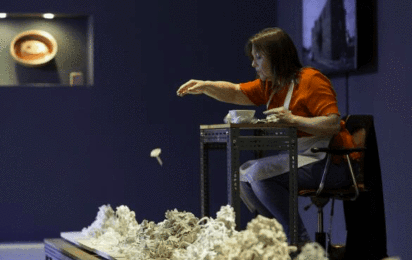WCP: Valuing a Lost Work Culture
Posted in Visiting Scholars | Tagged Art, John Russo, Manufacturing, Sherry Linkon, Tim Strangleman, United Kingdom, WCP, Working-Class Art, Working-Class Culture, Working-Class Perspectives
Beyond a paycheck, work fosters social connection, dignity, and a sense of creativity. In this week’s Working-Class Perspective, Tim Strangleman ponders whether the decline of older industries means that fewer workers engage art in their labor.
“As Rita continued to work she told us more about her working life. She described her first day on the line, learning, by one failed attempt after another, how to make basic flower shapes, and, through practice, to ensure each was of a consistent size and shape. Rita reminisced about the female supervisor, who was at first deadly strict with her new charges, brutally discarding the multiple failed attempts at the specified flowers.
Initially Rita had wanted to give up, but a mixture of family pressure and well-timed encouragement from her supervisor made her realise that she possessed the talent and ability to succeed in her new trade. Rita described beautifully her respect mixed with fear for the woman who taught her to make her first flowers. After a while, this changed to a far warmer relationship as the trainee proved herself capable, worthy of attention, and so the bond could form.
Rita’s story of her early working life is at once unique to her but also shared. She described the socialisation into economic life that many working-class people share. Of course, the material conditions vary enormously. The type of work clearly adds an important dimension, and the people we work with make a huge difference. However, there is a common experience of people socialised into work culture in traditional industries that transcends these differences. What Rita described, and what I have been lucky enough to record in my work and to read in the autobiographies of countless workers, is the process of being and becoming, of maturing in and through one’s work.
Fundamentally, though, this is a social activity, for what Rita and many others describe is the act of creating the social, of forming social bonds and relationships.
We often take these experiences for granted. They are, after all run of the mill encounters in the workplace. But in looking back at early work experience in later life, people are often more able and willing to reflect on the complexity of earlier interaction. It is perhaps only then that this early socialisation into work takes on a more complex hue. We may not have enjoyed the process of learning a new job. Indeed, we may have hated the work and loathed the people in charge of us. It is the passage of time that reveals a more rounded sense of what was at stake, what was of value.
Rita’s story, like the countless examples from my own research, reminds us of the surprising commonality of working-class life across time and space, but it also reveals the positive values hidden not so deep in working-class culture. As I have written here before, workers have good reason to feel nostalgia for these experiences. But what about contemporary workers?
Will the jobs and industries that working-class people ‘enjoy’ in contemporary society provide contexts that will nurture a vibrant culture in the future? Work today is more likely to be described using words like insecurity, precarity, fissuringand instability, words that reflect poor soil on which to grow the kinds of bonds and relationships that people like Rita and millions of others long knew. Today’s work culture seems distinctly different from what Rita recalls, and we should look at it critically, noting what working-class people have lost as work has changed. But this does not mean that people no longer seek meaning and connection at work. As scholars, we should look for evidence of how people humanise their lives now. It is worth asking, is there still an art to working-class labour?”
Read the entire post (new window) and check out other Working-Class Perspectives posts on our website.

